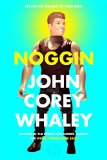Summary | Excerpt | Reviews | Beyond the Book | Read-Alikes | Genres & Themes | Author Bio

This article relates to Noggin
In John Corey Whaley's young adult novel, Noggin, 16 year-old Travis Coates undergoes a head transplant. Yes, a head transplant. As in his head is severed from his old body and reattached to a new body. Sounds like science fiction, right? It is…sort of. Cryogenics is the branch of physics that deals with the study of the production and behavior of materials at very low temperatures. Cryonics is the low-temperature preservation of humans in the hopes that they can be resuscitated and healed in the future.
In July 2002, Red Sox legend Ted Williams (The Kid) died at the age of 83. He lived in Florida. His 1996 will stated that he wanted to be cremated and have his ashes spread over one of his favorite Florida Keys fishing holes with his trusty Dalmatian dog, Slugger, who had died in 1999. Instead, according to Ben Bradlee Jr.'s book The Kid: The Immortal Life of Ted Williams, Ted Williams's body was flown to Arizona, to the headquarters of Alcor Life Extension Project, so that it could be cryogenically preserved. John-Henry, Ted's son, was the force behind this decision. A fan of Theoretical Medicine, the study of the philosophy and methodology of medical practice and research, he was excited at the prospect of being "reborn." Ted Williams never applied for the cryogenics project at Alcor, but John-Henry faxed them an application six hours before his father's death, supposedly with Ted's signature. Regardless, the son had power of attorney and was the health proxy for his dad. Ted was shipped there right after his death – packed in an ice box.
Alcor has been freezing bodies since 1976. When Ted Williams got there they had frozen 49 people and had what they call 590 "living members." (You pay $400 in annual dues to wait.) According to Alcor, as of February 2014 these numbers have grown: 121 people are frozen and 973 are living members. In cryonics, the brain is considered the most vital organ, and the idea is that the rest of the body can be regenerated using stem cells. So while some people choose to have their bodies frozen as well, the brain is the most important. Freezing the whole body cost, in 2002, $120,000. Freezing just the brain, which is called the "neuro," costs $50,000. And then there is the option that John-Henry chose: having both head and body frozen separately. John-Henry died two years later, at the age of 35, from leukemia, and had the same procedure done.
Alcor stores the heads and bodies in thermos-like tanks called "Dewars" filled with liquid nitrogen at -321 degrees F. Each Dewar is 10 feet tall and 3 feet in diameter, and can house up to four bodies and five heads. When full, the tanks weigh up to 5,400 pounds.
Cryonics is not a belief that the dead can be revived. Alcor states this repeatedly on its website. But it states that cryonics can work because of three things:
Filed under Medicine, Science and Tech
![]() This "beyond the book article" relates to Noggin. It originally ran in May 2014 and has been updated for the
March 2015 paperback edition.
Go to magazine.
This "beyond the book article" relates to Noggin. It originally ran in May 2014 and has been updated for the
March 2015 paperback edition.
Go to magazine.
Your guide toexceptional books
BookBrowse seeks out and recommends the best in contemporary fiction and nonfiction—books that not only engage and entertain but also deepen our understanding of ourselves and the world around us.